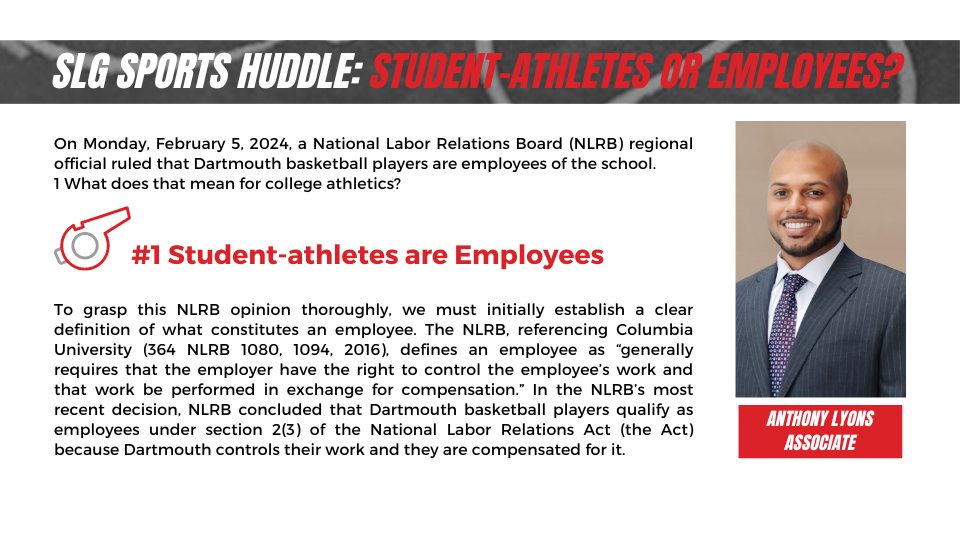
On Monday, February 5, 2024, a National Labor Relations Board (NLRB) regional official ruled that Dartmouth basketball players are employees of the school. 1 What does that mean for college athletics?
#1 Student-Athletes are Employees?
To grasp this NLRB opinion thoroughly, we must initially establish a clear definition of what constitutes an employee. The NLRB, referencing Columbia University (364 NLRB 1080, 1094, 2016), defines an employee as “generally requires that the employer have the right to control the employee’s work and that work be performed in exchange for compensation.” In the NLRB’s most recent decision, NLRB concluded that Dartmouth basketball players qualify as employees under section 2(3) of the National Labor Relations Act (the Act) because Dartmouth controls their work and they are compensated for it.
Throughout the creation of the NCAA and college athletics, student-athletes are not considered employees. The crux of the NCAA is that student-athletes are amateur athletes who do not receive any additional benefit over any other student-athlete for participating in their sport. Specifically, the NCAA has defined an “Amateur” as someone who does not have a written or verbal agreement with an agent who has not profited above their actual and necessary expenses or gained a competitive advantage in their sport. 2
Before attending any NCAA institution, student-athletes must sign a National Letter of Intent indicating they have committed to attending and competing for an NCAA college or university in exchange for athletics-based financial aid. All major institutions require student-athletes to maintain their Amateur status to remain eligible to compete in Division I sports. Once student-athletes arrive on campus, they must review, sign, and acknowledge a Student-Athlete Handbook, a summary of NCAA regulations, and an NIL waiver.
With the evolution of college athletics and NIL, student-athletes argue that they are employees because the institution’s Athletic Department works for the business of benefiting the institution.
Through its own business office, fundraising department, marketing department, and brand management department to handle the revenues and publicity generated by Division I intercollegiate athletics, their participation benefits their institutions, and they should receive compensation for their services.
#2 Compensation
First, compensation can and should be viewed in many forms. The typical compensation model of providing a service or product in exchange for US Dollars is not the only means of compensation. In their decision, the NLRB considered benefits provided to the Dartmouth basketball players, such as
The benefits of “early read” for admission prior to graduating high school. They also receive equipment and apparel – including basketball shoes valued in excess of $1000 per player per year – as well as tickets to games, lodging, meals, and the benefits of Dartmouth’s Peak Performance program. Decision and Direction of Election-Trustees of Dartmouth, Case 01-RC-325633.
1 Decision and Direction of Election-Trustees of Dartmouth
2 https://www.ncaa.org/sports/2014/10/6/amateurism.aspx
#3 Right To Control
Second, the institutions have the right to control the student-athletes’ work. As described above, student-athletes receive the Student-Athlete Handbook, a summary of NCAA regulations, and a NIL waiver when they arrive on campus. These documents could and should be considered an employee handbook because they set forth the guidelines student-athletes must follow to remain eligible for competition. Institutions may argue that student-athletes can decide what classes they may take, when to go to class over practice, and other personal decisions surrounding athletics.
The record and history of student athletics reflect a different story. Student-athletes receive memos recommending class schedules that don’t interfere with athletic participation and improvement.
Student-athletes testify to repercussions and punishments for not attending practices or choosing to attend class over athletic activities, such as losing playing time and other losses.
In conclusion, institutions have a track record of dictating how student-athletes perform their work, and student-athletes receive compensation for these tasks. Therefore, in Dartmouth’s petition, the NLRB decision is correct that the basketball team student-athletes are classified as the institution’s employees.
Depending on the institution, student-athletes can be classified as employees. The employee classification does not apply to all student-athletes because the Act requires multiple considerations, not limited to whether the student is a scholarship or walk-on athlete, the sport generates revenue, the school is private or public, the purpose of the athlete playing the sport, or whether academics are favored over athletics.
Regardless of the NLRB’s finding, the tidal wave of change to college athletics will continue with the changes in NIL rules. Stay tuned to SLG’s sports post to hear our opinion on college athletics and NIL updates.

